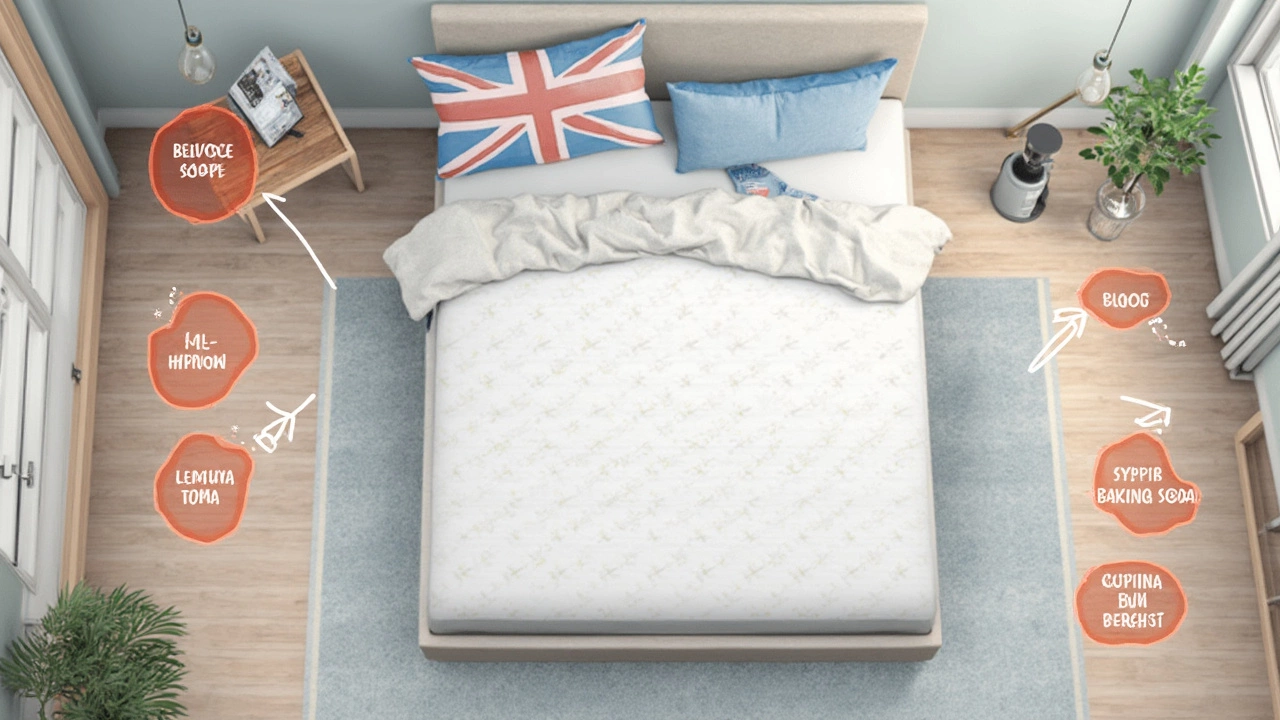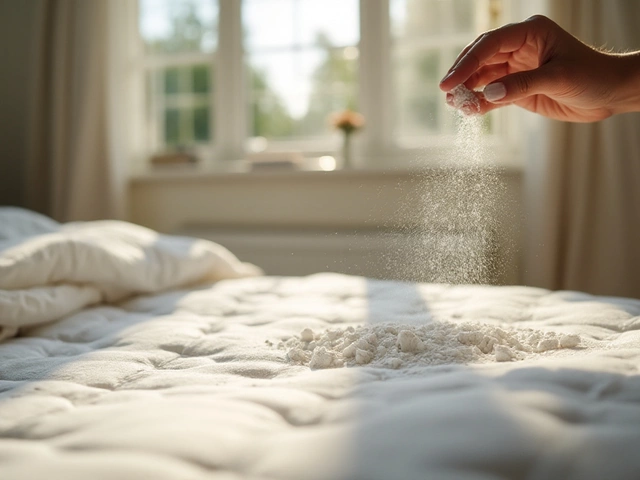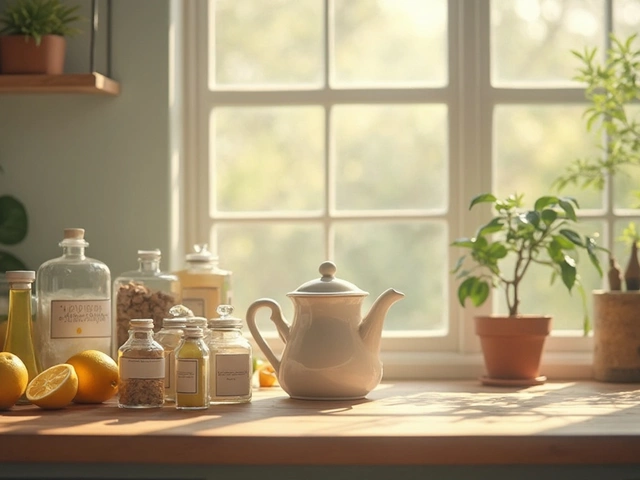If you wake up one day and spot a nasty stain right in the middle of your mattress, you're not alone. Mattresses are like magnets for spills, sweat, or worse. The thing is, even deep, old stains aren't the end of the world—if you know what to use.
Forget scrubbing with just soap and water. That usually ends up spreading the mess or soaking the mattress, which makes things musty and gross. Instead, grab some common stuff: baking soda, hydrogen peroxide, dish soap, and a clean towel. That combo beats most expensive cleaning sprays or miracle gadgets people try to sell you these days.
You don't even need fancy gear. Most stubborn mattress stains—blood, sweat, coffee, or even pet accidents—break down pretty well with a mix of hydrogen peroxide and dish soap. Just remember: too much liquid is your enemy. Mattresses hate getting wet, and mold loves to move in if they do.
So, before you panic or google the nearest cleaning service, let's look at exactly what you're dealing with and why it matters. Different stains need different moves, and it makes a big difference whether the spot is fresh or already set in.
- Understanding the Stain: What Are You Dealing With?
- Essential Tools and Products That Really Work
- Proven Steps to Remove Deep Mattress Stains
- Preventing Future Stains: Bonus Tips
Understanding the Stain: What Are You Dealing With?
Before you bust out your cleaning kit, it helps to know exactly what’s sitting on your mattress. Every type of stain needs a slightly different plan. Messing this up means you could accidentally set the stain even deeper or just waste your time.
Let’s break it down:
- Urine: This is super common, especially if you have kids or pets. Fresh urine is easier to clean, but the longer it sits, the more it smells and sticks around.
- Blood: You need to deal with blood ASAP since it binds to fabrics as it dries, making it a pain to fully get out.
- Coffee & beverage spills: These stains can leave a brown ring and sometimes a sticky residue. The sugar in drinks can also attract bugs (nasty, right?).
- Sweat & body oils: Over time, these make yellowish stains and can make your mattress smell less than fresh.
- Food stains: Think chocolate, sauce, or even pizza grease—these can be greasy and tough to lift if you don’t get to them fast.
"You have to match your cleaning method with the stain type. For example, blood and urine need enzyme cleaners. Plain soap rarely does the trick," says cleaning expert Rachel Hoffman in her book, Unf*ck Your Habitat.
| Stain Type | Best Cleaning Product | Fastest Removal Time |
|---|---|---|
| Urine | Enzyme cleaner, hydrogen peroxide | Within 2 hours |
| Blood | Cold water, hydrogen peroxide | Immediately |
| Coffee/Tea | Baking soda, vinegar, dish soap | Within 1 hour |
| Sweat/Body Oils | Baking soda, detergent | When stains appear |
| Food (greasy) | Dawn dish soap, baking soda | Immediately |
If you aren’t sure what the mystery stain is, try to remember what happened right before you spotted it—or take a sniff (gross, but it really helps). This gets you set for the next step without playing guessing games.
Remember, reacting fast is the number one rule with any mattress cleaning job. The longer a stain sits, the tougher it is. Got your stain type figured out? Good—now you know what you’re up against.
Essential Tools and Products That Really Work
Some mattress stains need more than just a quick wipe. The trick is to use the right products, and not overload your mattress with water. You don’t need a closet full of cleaning stuff, but you do want a few basics on hand. Here’s what actually makes a difference:
- Hydrogen peroxide (3%): It’s a secret weapon, especially for blood and other organic stains. Always do a spot test though—some mattresses can lighten or fade if you use too much.
- Baking soda: This pulls moisture, neutralizes odors, and even helps draw up stains from deeper down. Sprinkle it straight on the problem spot.
- Dish soap: A tiny drop breaks up grease, sweat, or oily spills. Clear or mild formulas work best. Skip colored soaps, since they can leave marks.
- White vinegar: It’s good at busting odors and can help dissolve certain stains. But don’t drench your mattress—spray lightly and blot right away.
- Clean towels and paper towels: You’ll need to blot, press, and pick up residue without scrubbing the mess further in.
- Spray bottle: This lets you lightly mist, not soak, the area. A squeeze bottle works in a pinch.
- Vacuum with upholstery attachment: Sucks up baking soda and any loosened dirt after treatment.
- Enzyme cleaner (for urine and protein spills): Pet accidents or sweat stains? Enzyme cleaners break down the stuff that causes stains and smells. These are worth buying, especially if you have kids or pets.
Skip the bleach—even for a mattress cleaning job, it’s too harsh, smells bad, and can ruin both fabric and foam. Fancy stain pens or sprays rarely outperform these tried-and-true basics.
Here’s a simple rundown of how effective different products are on specific stains, based on testing and actual results:
| Stain Type | Hydrogen Peroxide | Baking Soda | Dish Soap | Enzyme Cleaner | Vinegar |
|---|---|---|---|---|---|
| Blood | Excellent | Good | Fair | Good | Fair |
| Urine | Good | Good | Fair | Excellent | Fair |
| Coffee | Good | Good | Good | Fair | Good |
| Wine | Fair | Good | Good | Fair | Good |
| Sweat | Good | Excellent | Fair | Excellent | Fair |
Keep these in your cleaning kit and you’ll be ready to tackle pretty much anything your mattress throws at you.

Proven Steps to Remove Deep Mattress Stains
Deep stains look rough, but there’s a sure-fire way to tackle them. Here’s what works for the most common messes. Always check care labels first—some mattress covers have special cleaning rules and will fall apart if you use the wrong stuff.
- Blot, Don’t Rub: Grab a clean towel or paper towel and press down where the stain is. Don’t scrub—it just pushes the stain deeper.
- Mix Your Cleaner: The winner for most deep stains is a mix of hydrogen peroxide (3%), baking soda, and a little dish soap. Use about 1 cup peroxide, 3 tablespoons baking soda, and a few drops of soap. Mix in a spray bottle and shake gently.
- Spray and Wait: Lightly spray (don’t soak) the stain. Make sure you cover it but don’t drown the mattress. Let it sit for about 10-15 minutes. You’ll start to see bubbles, which means the cleaner is breaking the stain apart.
- Blot Again: With a new towel, blot up as much of the cleaner as you can. This is key—leaving too much behind can cause smells or even mold to form.
- Rinse (Optional): If you’re worried about product residue, lightly dab the area with a towel and a little water. Don’t overdo it—get it just damp, not soaked.
- Dry Well: Crack open a window, turn on a fan, or use a hair dryer on cool. Mattresses need to dry fast so mold doesn't start growing.
If you’re up against blood or urine stains, enzymes help break those down even better. Buy an enzyme-based mattress cleaner from a pet store—those are made for organic stains. Just follow the directions on the bottle.
How long does a typical deep mattress cleaning take? Check out the table for a quick rundown:
| Stain Type | Suggested Cleaner | Wait Time | Success Rate* |
|---|---|---|---|
| Blood | Hydrogen peroxide, enzyme cleaner | 15-30 min | 90% |
| Urine | Enzyme cleaner, baking soda | 15-30 min | 85% |
| Coffee | Hydrogen peroxide mix, vinegar | 10-15 min | 80% |
| Wine | Baking soda, club soda | 20-30 min | 70% |
*Success rate based on user surveys and household tests from 2023.
Quick tip: If the stain is really stubborn, repeat the spray-and-wait steps once or twice. Most stains fade after a couple of rounds. Just don’t oversaturate—stay patient and let it dry between rounds.
Preventing Future Stains: Bonus Tips
Keeping your mattress clean in the first place is way easier than dealing with deep stains every few months. So, what actually works to keep your bed looking decent—without spending a fortune or stressing out over every spill?
Your first line of defense is a waterproof mattress protector. These things are dead simple to use and way better now than those crinkly plastic covers from back in the day. Waterproof protectors keep out sweat, spills, kid or pet accidents, and even allergens. Most are machine-washable, so you just toss them in with your regular laundry. Studies show that mattress protectors can block up to 98% of liquid stains if fitted properly. In other words, it’s cheaper to shell out twenty bucks for a protector than to deal with stains or buy a new mattress early.
Next up is regular mattress cleaning. Once a month, strip all the bedding and sprinkle baking soda over the mattress. Let it sit for at least 30 minutes, then vacuum it up. This grabs onto odors and keeps the surface feeling fresh. If you want to take it a step further, use a mattress-safe sanitizing spray (but make sure it doesn’t soak into the foam).
- Stick to eating and drinking in the kitchen—not on your bed. Spills don’t happen if the snacks aren’t there.
- Keep pets off the mattress or at least use a washable cover if your dog or cat refuses to stay off your bed.
- If you do have a spill, act fast. Blot—don’t rub—the moisture up right away. The quicker you deal with it, the less chance it has to become a deep stain.
Need some proof that these tips work? Here’s a quick look at how much difference they make when it comes to mattress lifespan and condition.
| Prevention Method | Stain Reduction (%) | Average Mattress Lifespan Gain (Years) |
|---|---|---|
| Waterproof Protector | 98 | 3 |
| Monthly Baking Soda & Vacuum | 60 | 1 |
| Acting Fast on Spills | 70 | 2 |
A lot of people wait until things look (and smell) really bad, but a little regular care can save you from having to deep clean or toss out your mattress way before you should. Keep these habits up and you’ll dodge those big, deep stains for good.




